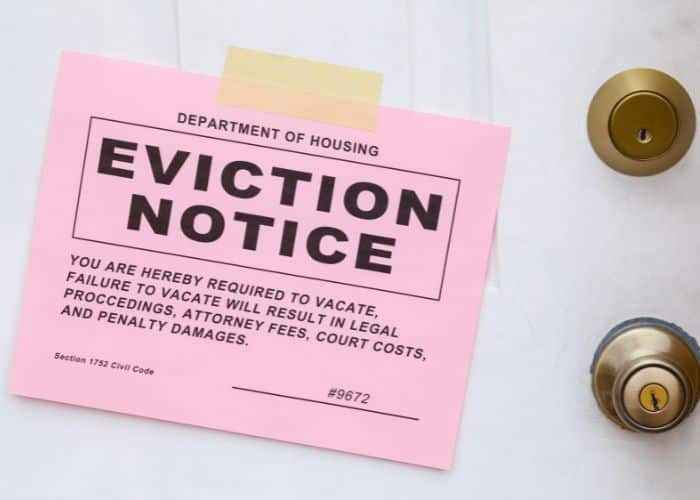Understanding California Eviction Laws (2024 Guide)
The eviction process can be difficult and tends to draw out a lot of emotions, both for tenants and landlords. California has some intensely elaborate housing laws so going through the process of eviction requires a full knowledge of legal requirements, possible outcomes, and involved costs.
This article will provide a thorough overview of the eviction process in California, including the reasons for eviction, approaches to prevent eviction, the steps involved, and what costs are to be expected.
Reasons for Eviction in California
There are several reasons that an eviction might occur in California. However, for all those reasons, they are labeled as either at-fault or no-fault. Whether they fall under one heading or the other sometimes comes down to what the law allows in terms of evictions.
At-Fault Evictions
An at-fault eviction starts from a violation of the lease agreement on the side of the tenant. A few of the most common reasons include causing large amounts of property damage, doing illegal acts on the premises, breaching the terms of the lease, or failing to pay rent. Landlords have the right to evict a tenant for any of these reasons if they provide appropriate notice and adhere to all legal procedures.

No-Fault Evictions
A no-fault eviction is the opposite of one that is at fault. It happens when a landlord wants to end a tenancy, but the tenant has done nothing wrong. A few of the reasons for this might be large renovations or repairs that require the property to be vacant, owner move-ins, or the need to remove the property from the rental market. Tenants may not have done anything to breach the lease agreement. Landlords can still start the eviction proceedings in some situations.
Banned Reasons for Eviction
While there are many reasons a landlord can initiate eviction, that doesn’t mean every reason is allowed. California law makes it illegal to evict someone based on certain retaliatory or discriminatory reasons. Landlords are prohibited from evicting tenants based on their race, nationality, familial status, religion, gender, disability, or other protected characteristics. It’s also not allowed to retaliate against a tenant who is exercising their legal rights, such as joining a tenant union or reporting code violations.

Knowing the difference between at-fault and no-fault evictions, as well as the prohibited reasons for eviction, is essential for landlords who wish to approach the process ethically and legally.
This ensures tenants are treated fairly and landlords adhere to state laws about landlord and tenant relationships.
How to Evict a Tenant in California
Evicting a tenant in California is a legal process that has several steps involved. In addition, you need to adhere to certain requirements. From trying to negotiate to getting a court decision, landlords need to move through the eviction process with precision to ensure they comply with all state laws while protecting their rights.
Attempting Negotiations
Before starting the formal eviction proceedings, landlords should always try to negotiate with the tenant to resolve any problems positively. Mediation and open communication can often lead to a compromise that suits both sides and avoids the need for legal action. Landlords can talk about concerns with tenants, like lease violations or late rent payments, and work together to find a resolution that both sides agree on.
Negotiation can also involve solutions like offering alternative payment arrangements, providing time for the tenant to resolve lease violations, or addressing repair and maintenance issues. Creating a cooperative situation and showing willingness to work with tenants can help landlords avoid issues that turn into eviction.
Steps of the Eviction Process
Giving Notice
In most cases, the first step in the eviction process involves the landlord providing a written notice to the tenant. This notice should explain the reason for the eviction and share a certain period during which the tenant can vacate the property or remedy the current problem. The type of notice is going to vary based on the reason for eviction, such as termination of tenancy, lease violations, or failure to pay rent.
Landlords must make sure they draft the notice property and state the reason for the eviction while complying with all state requirements about delivery methods and notice periods. Not doing so can create complications and delays that make the eviction process even more frustrating. Giving notice is the start of the formal eviction and lets tenants know they need to make changes before legal action occurs.
Filing with the Court
If the tenant doesn’t comply with the notice, the landlord can then move forward with filing an eviction lawsuit, known as an unlawful detainer action, with the appropriate court. The landlord needs to turn in all required documents, including the notice filed to the tenant and other supporting evidence. There will also be filing fees that need to be paid.
Filing paperwork is a critical part of the process and shows that things have moved to the legal arena. Landlords need to make certain they have turned in all needed documents in the period required to avoid additional complications in this process. Professional assistance is often helpful at this stage of the process.
Filing with the Court
If the tenant doesn’t comply with the notice, the landlord can then move forward with filing an eviction lawsuit, known as an unlawful detainer action, with the appropriate court. The landlord needs to turn in all required documents, including the notice filed to the tenant and other supporting evidence. There will also be filing fees that need to be paid.
Filing paperwork is a critical part of the process and shows that things have moved to the legal arena. Landlords need to make certain they have turned in all needed documents in the period required to avoid additional complications in this process. Professional assistance is often helpful at this stage of the process.
Dismiss, Default Judgement, or Trial
After the lawsuit has been filed, the court will choose a time for a hearing so the case can go through. Tenants can respond to the lawsuit at this time by going through the courts and contesting the eviction. If the tenant doesn’t respond promptly, the court will often issue a default judgment in the landlord’s favor. On the other hand, they may schedule a trial to hear arguments from each side before deciding.
Both the landlord and the tenant must adhere to court deadlines and procedures throughout the process to ensure a quick and fair resolution to the dispute. Seeking legal advice from an attorney familiar with landlord and tenant laws can help either side make it through the process while protecting their rights.
By actively participating in court proceedings and offering crucial evidence and legal arguments, landlords and tenants alike can advocate for their own interests and ensure a fair outcome at the end of the eviction process.
Decision
After the trial, the court will decide how the eviction will move forward. If the court chooses to rule with the landlord, a judgment may be issued telling the tenant to leave the property by a specific date. In addition, the court could award monetary damages to the landlord or property damages or unpaid rent if either is appropriate.
The court decision at the end of the process will have major consequences for everyone involved in the eviction process. It gives information about the legal obligations and rights of the tenant and landlord. It also acts as a final resolution to the dispute based on the arguments and evidence that were brought up in the trial.
Evicting a tenant in California requires careful consideration of the legal procedures and requirements. Starting with negotiation and then following the steps above will give landlords a guide to get through the process and protect their interests while meeting all requirements of eviction.

Cost Breakdown of a California Eviction
There are various costs that landlords may need to deal with in terms of tenant eviction in California. These range from property damages to legal fees. Understanding how these expenses might break down as you move forward is essential for a landlord who wants to move into eviction proceedings with a full understanding of what is still to come.
Attorney Fees
One of the most substantial expenses related to evicting a tenant is hiring an attorney to help you with the legal parts of the eviction process. It is not required for a landlord to have any legal representation, but most do bring in lawyers to make sure they meet all state laws, can have legal documents drafted, and have an extra person to represent their interests in court.
The fees for an attorney will vary based on how complex the case is, the length of the eviction proceedings, and the hourly rate of the attorney. If the case is uncontested and the tenant leaves the property without a fight, the fees can be reasonable in many circumstances. However, a contested eviction that includes court appearances and litigation may end up costing much more for the landlord.
Court Fees
Filing an eviction lawsuit with the court does involve various fees, such as service of process fees, filing fees, and other court-related expenses. Those fees might be small, but they add up once you start to calculate them all. This is especially accurate if the eviction process is extended or you need to show up to several court hearings.
In California, the court filing fees for an eviction case will depend on factors like the form of eviction and what county the lawsuit is filed in. Landlords need to budget for all these expenses when starting the eviction process. In addition, they should be ready to cover additional costs associated with document filing and court appearances.
Lost Rent
While the eviction process is underway, landlords might have issues with lost rental income. This is most common if the tenant stays in the property and does not continue to pay rent. Tenant appeals, delays in the legal process, or extended court appearances can increase the time it takes to regain access to the property so it can be rented out to other tenants.
Lost rent can be a serious financial burden for landlords. It can cut down on their income while also impacting their ability to pay property taxes, mortgage payments, and other operational expenses. Landlords need to consider the potential loss of rent when thinking about the complete cost of eviction. It may be worth looking into strategies to minimize vacancy and periods of downtime.
Property Damage
In some situations, tenants will create damage to the rental property, which can add additional costs for the landlord. Property damage can range from small bits of wear and tear to serious destruction of appliances, fixtures, and structural parts of the property.
Landlords will often need to put money and time into restoring or repairing the property to make it as nice as it started. This will need to be done before renting it out to different tenants. On top of that, if the damage is more than the security deposit that the landlord holds, they may need to move forward to legal action to get the compensation needed for replacement or repair costs.
There are numerous costs associated with evicting a tenant in California. Landlords should consider them when looking at the pros and cons of choosing eviction proceedings. Understanding the breakdown of costs like lost rent, property damage, attorney fees, and court fees is a good way to be informed and move forward with confidence.
Strategies for Landlords to Prevent Evictions
For most landlords, eviction is a last resort for tenant-related issues. It can be time-consuming, costly, and emotionally draining for everyone involved. The good news is that there are proactive methods for landlords to avoid eviction and keep a positive relationship with their tenants.
Thorough Tenant Screening
One of the most effective methods to prevent eviction is by having a thorough client screening before signing any kind of lease agreement. Tenant screening is a process where the tenant is assessed on their rental history, employment status, creditworthiness, and references. This gives insight into whether they would be a good renter.
When landlords rigorously screen tenants, they can see red flags like prior evictions, history of late rent payments, and negative references from past landlords. Having this information lets landlords make more informed decisions about whether or not to rent someone. This can also cut down on the chances that eviction-related issues occur in the future.
Landlords should make sure to use rental application forms, verify employment and income information, and conduct credit and background checks to ensure possible tenants are a good fit for their properties. While it might require an investment in time and resources, it can save landlords from the stress and expenses associated with an eviction

Negotiation as a First Resort
We mentioned negotiation earlier, but it bears touching on it again. If there is any kind of conflict between a landlord and tenant, this is where you should start. Constructive conversations and open communication can be the key to finding solutions that address issues and prevent the need to move into the eviction process.
As a landlord, you want to be willing to listen to the tenant’s concerns and compromise so you both get something out of the process. For instance, you might extend the deadlines for payments, take new forms of payment, or handle other issues that are bothering the tenant whom you would prefer to keep in the property.
Landlords need patience, empathy, and a commitment to finding common ground to do well in a negotiation. Strive to keep the relationship with tenants positive while addressing the issues they have as long as they are in your property. When you prioritize talking, it’s easier to resolve things in a friendly way and may avoid the need for eviction proceedings.
Insights from Property Managers
Property managers are an integral part of helping landlords navigate tenant relations and property management as a whole. Using their experience and expertise, landlords can get important advice and insights about how to prevent eviction from becoming a requirement. Property managers can help with conflict resolution, rent collection, lease enforcement, and tenant screening to address and identify issues before eviction is needed.
Landlords can gain guidance about laws and regulations from property managers, which is important so the landlord stays compliant in terms of local and state housing laws. Being aware of the responsibilities and rights of landlords makes a property manager able to help them move through legal challenges and avoid most eviction situations.
In addition, property managers can be a neutral third party in disputes between tenants and landlords. They can help with good communication and finding solutions that work for both sides. Their diplomatic approach and objective perspective may help down the tension and prevent any conflicts from getting worse.
All in all, eviction can be avoided if proactive steps are taken before that. Collaboration and effective communication are both important between property managers, tenants, and landlords. Conducting comprehensive tenant screening, prioritizing negotiation, and seeking assistance from property managers
Final Recommendations for Landlords
Landlords should take proactive steps to avoid eviction and create positive relationships with tenants. By following the recommendations throughout this article, such as seeking professional guidance, staying informed, and prioritizing negotiation, landlords will have less likelihood of needing to take on the eviction process.
Eviction isn’t always avoidable, but landlords can cut down on risks and promote successful tenancies by being fully aware of the eviction process, communicating transparently, and reaching out to help when it is needed. Simply having a pleasant relationship with tenants and working with them instead of against them can have major benefits for everyone.
24 hours a day —We're here for you
Request a Free Rental Property Evaluation
Phone
Hours
Open 24 Hours
Schedule A Free Consultation

